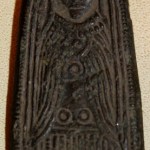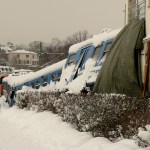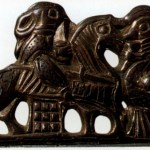

Aardvarchaeology
Dr. Martin Rundkvist is a Swedish archaeologist, journal editor, public speaker, chairman of the Swedish Skeptics Society, atheist, lefty liberal, board gamer, bookworm, and father of two.
Some recent Facebook updates of mine:
After four years' living in this house I just stubbed my toe on the bathrooom threshold for the first time -- painfully. Unusually, I was wearing semi-industrial hearing protectors on my way to the john -- because also unusually two people were watching TV at the same time and so the sound was on (I can't write with speech in the background). Now I wonder -- am I unconsciously in the habit of using the acoustics of our rooms to remember where I need to mind my step?
To solve the US gun problem, impose a 1900% luxury tax on ammo. Let the people bear arms…
Another one of the rare production dies for 6/7/8th century gold foil figures has come to light, again on Zealand! This is an unusual design depicting a lady from the front. She's wearing a long dress, a cloak and two bead strings. She seems to be cupping her hands around a ring at her abdomen. The rings on her dress hem are quite odd. Parallels to the general motif and design are known from Eketorp on Öland (a foil) and Sättuna in Östergötland (a die). Congratulations to detectorist Hans, and thanks for doing other folks with an interest in the past a big favour!
Update 4 Feb: Aard regular…
The Kachingle social micropayment site has been nagging me periodically for the past year. It's something along the lines of Flattr, and finally I thought OK, let's try this out. All they want from me is my email address and my permission. And would you believe it – I just got a US cent. Micropayment indeed. Looking at their web site it seems that there's a way to make those cents arrive more often by installing a clickable widget. But it looks a lot like the only way for me to get that widget is to start putting money into the system myself as a subscriber. Pyramid scheme, much?
So, Dear…
Reading a term paper by one of my Växjö students, I learned something surprising.
Being a well-read and erudite sort, Dear Reader, you may not be surprised. You already know that Japanese women have been having very few babies each since the 1950s, and that thus there's a growing shortage of strong young people to work in the care for the elderly. It has gone so far, and the prognosis is so dire, that the Japanese electronics industry is busy developing robots to care for old folks.
What I learned is that the problem is really one of xenophobia. All of Japan's neighbouring countries across…
Teaching 20-year-olds for the past term has begun to make me feel a little avuncular. But yesterday I had this sudden surge in my avuncularity. First, in the morning I finally took the step of shaving the sparse fuzz remaining on my forehead all the way up to the coronal suture. (That's the lateral seam in your skull that you feel if you put three fingertips between your eyebrows and slide them up to the top of your head.) To salvage a little dignity, I've always been one step ahead of the male pattern baldness.
Then I talked to the heat pump repairman (31) about what it'll be like for him to…
A teenage boy carved this imagery, along with some lines of runic script copied from a book, onto a Viking Period whetstone he found in a Sigtuna spoil dump.
Read it all on-line, Open Access!
Lars Larsson presents some Late Palaeolithic antler artefacts from Scania.
Olle Andersson makes and tests lots and lots of spearheads to investigate how the Iron Age ones found at Uppåkra got all bent and curled up.
Helmer Gustavson announces the confession of the man who faked the Sigtuna runic whetstone, and looks at how scholars have dealt with this strange object in their writings.
Timo Salminen…
Junior and I met this guy in the line to the EuroGamer Expo in London last September. Anybody know him?
When I was an undergrad in 1990 we were taught that all six periods of the Scandinavian Bronze Age were 200 (or in one case 300) years long. The most recent radiocarbon work shows that they all had different lengths and were more likely 130-280 years long. And the periods with the most abundant metalwork finds, II and V, are the two shortest. So their previously known status as metal-rich eras looks even more pronounced now, and the intervening periods look even poorer.
Per. I. 1700-1500 cal BC (200 yrs)
Per. II. 1500-1330 (170 yrs)
Per. III. 1330-1100 (230 yrs)
Per. IV. 1100-950/20 (165 yrs…
Most prosperous countries have legislation for what kinds of archaeological finds a citizen has to hand in to the authorities. In Denmark, still using a Medieval term, such finds are termed danefae, "property of the dead". And here is Danish TV4's list of the top-10 such finds of 2012. All but one of them have been handed in by detectorists, and two by Swedish detectorists operating in Denmark because of Sweden's restrictive rules!
It wouldn't really be worthwhile to make a top-10 like this for Sweden, as the pretty gold & silver metalwork they concentrate on in the program is usually…
Paul Peters, Hindawi Publishing
The Scholarly Open Access web site says that Open Access journal house Hindawi Publishing may show some predatory characteristics. I've simply called Hindawi "dodgy". Their Chief Strategy Officer Paul Peters commented here on the blog and then swiftly replied to some questions of mine, showing that the firm realises that its on-line reputation is important to success. Here's what Mr. Peters says.
MR: Why did Hindawi's Journal of Archaeology go on-line months before it had any papers?
This is generally the case for all new journals that we launch, and I…
Damn, I must have ridden those very train carriages thousands of times! The crash happened just four stops up the commuter train line from where I live. My wife and I went there this morning with our camera. Details here.
.
Update 21 January: On the basis of first reports and information from a former railway employee, I thought this was an ostentatious suicide attempt. Now there are indications that it was a horrific accident caused by the unsanctioned habits of train drivers. Apparently they routinely jury-rig the safety apparatus for convenience, and in cold weather, to keep the brakes…
Selected Facebook updates:
Dreamed that a podcaster had mixed ham, celery and rice crispies into my favorite tea leaves. Was very angry.
Green tea leaves accumulate in our house way faster than we use them. Bothers my logistics brain.
Misread a headline on a lady's magazine. "A Retro-Style Wedding" became "A Hetero-Style Wedding".
Genital lambada, Sw. könslambada. That's what exceptionally witty Black Metal blogger Hatpastorn calls it.
I just realised that penguins are aquatic polar dinosaurs. Darwin FTW!
The Mandelbrot set has the nicest ass in all of mathematics.
Swedish internet users are…
Current Archaeology #273 (Dec) has an interesting feature on an 18th century ship of the line found hidden as a construction kit under the floor of a workshop at a naval dockyard in Kent. The timbers were re-used, but not in an economically or structurally rational way. Instead the greatest possible amount of ship's timbers had been crammed in under the floor. Markings on them and historical records identify the ship as the HMS Namur, famous in its time for the battles it fought. It was launched in 1756 and broken up in 1833-34.
Investigators have put forward an interesting suggestion as to…
My boss at the Academy of Letters used to head the National Archives. Here's a story he told over coffee the other day.
Some decades ago a delegation of Swedish archivists was driving across the American Midwest to visit a Mormon microfilming facility. Stopping in a small town for lunch, they noticed that it had an unusual name in a Native American language. At a fast food restaurant, the head of Stockholm's town archives asked the cashier,
"Excuse me miss, we're from Sweden and this place has such an unusual name. Could you please tell me how to pronounce it?"
The young lady stared at him…
Two years ago I was dismayed to find that a pair of crank authors had managed to slip a pseudo-archaeological paper into a respected geography journal. Last spring they seemed to have pulled off the same trick again, this time with an astronomy journal. Pseudoscience is after all a smelly next-door neighbour of interdisciplinary science.* When I realised that the second paper was in a bogus Open Access journal, I drew the conclusion that the authors had fallen for a scam, paying the OA fee to get published in a journal whose academic standing they had severely misjudged. That's still my…
Ferdinand Balfoort contributes a guest entry upon a recent ancestral pilgrimage to Stockholm.
I gladly agreed to write something for the blog after being introduced by Martin to a book by Frans G. Bengtsson about Early Modern Scottish brigades (and brigadiers) in the Nordic region including Sweden. I visited Stockholm in December on my quest to find my 16th century ancestor Gilbert Balfour who lost his head during a public decapitation procedure with a sharp implement, somewhere in the Old Town. So far I am no closer to retrieving his head or his grave site, but some illumination has been…
Hot on the heels of the hapless Science Publishing Group, I have received solicitation spam from another dodgy OA publisher, Hindawi Publishing in Cairo, with another odd on-line archaeology journal.
The Journal of Archaeology has 71 academics on its editorial board. And a strangely generic name. What it doesn't have is any published papers yet, after months on-line, or an editor-in-chief. So I wrote to some board members at European universities, and they replied that they thought the journal was probably legit, though they weren't exactly sure. "The lack of published papers and low…
Selected Facebook updates:
John Lennon offers a grammar lesson: "A working-class hero is something to be". It's an adjective and a noun. Not a verb.
A friend of mine is rehearsing Orff's Carmina Burana and not loving it: "I'm liking the work less with every rehearsal and we're performing it three times in one week, so pity me in my Nazi-approved quasi-Medieval dungeon where the artistic ceiling is looow indeed!"
Kelly Link believes that reindeer have manes.
Swedish Xenophobe Party tries to get Parliament fact finders to list MPs with foreign citizenship. You couldn't make this up.
The next…
Etymologically speaking, ”valkyrie” means ”chooser of the slain”. The job of these supernatural shield maidens in Norse mythology is to select who dies on the battlefield and guide their souls to Odin's manor, where they will spend the afterlife training for the Twilight of the Gods, the final battle against the forces of chaos. After each day's combat training, a mead-hall party with drink and reincarnated pork ensues, with the valkyries waiting the tables.
We have had very few period depictions of armed women. Instead scholars have applied the term “valkyrie” to a common Late Iron Age motif…
I found some slightly mouldy bread in the cupboard, cut off the mould and made toast. And I thought about bread and microbes.
For flavour, not as a raising agent, I make sour dough. My method is simple: I mix rye flour with water in a glass, cover it with cling film and put it on the countertop for a week or so. Lactic acid bacteria soon colonise the mix, lowering the pH to make the environment cosy for themselves and deter any other opportunistic microbes.
When the sour dough smells like vinegar I make bread dough with it, adding a second microbe: yeast fungus. The yeast eats sugar in the…








